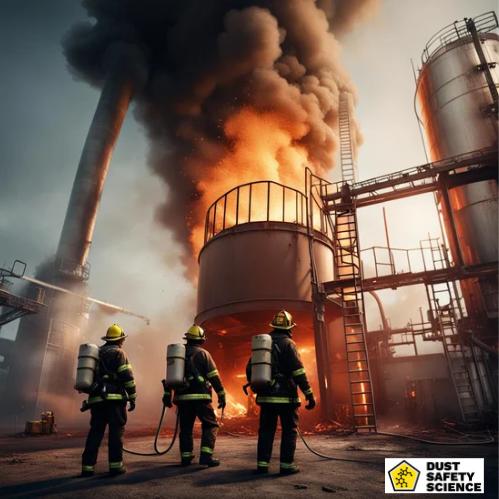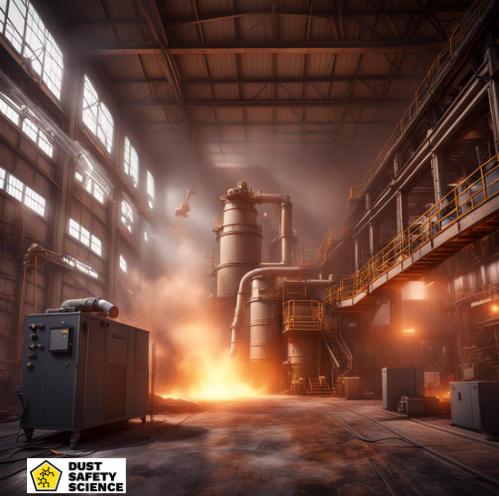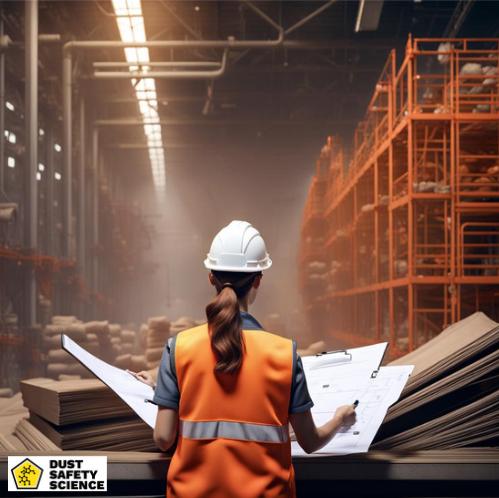Updated December 31, 2024 Authored by Dr. Chris Cloney and Jon Barrett of Dust Safety Science

Key Takeaways:
- Effective Combustible Dust Control Systems: Learn how to implement robust combustible dust control systems, dust collectors, dust collection, and solutions to enhance workplace safety and prevent hazardous incidents, and prevent combustible dust explosions.
- Combustible Dust Management Techniques: Explore a variety of strategies and methods for the collection and cleaning of combustible dust, including industrial dust collection systems for safeguarding your facility from potential ignition sources, and prevent combustible dust explosions.
- Compliance and Best Practices: Stay up-to-date with industrial dust collection systems, dust collector and dust collection compliance requirements and discover best practices to maintain a combustible dust-free environment, promoting a secure and efficient workspace, and prevent combustible dust explosions.
Definition of Combustible Dust Control System
A Combustible Dust Control System is a specialized set of measures and equipment designed to mitigate the risks associated with combustible dust. Combustible dust consists of fine particles that can ignite and explode when suspended in the air in specific concentrations. Industries dealing with materials such as wood, coal, metal powders, chemicals, pharmaceuticals, and food processing are susceptible to combustible dust hazards, and health hazards, such as silica dust, and other materials, and require a dust collector and industrial dust collection systems.

Importance of Dust Control in Various Settings
The significance of implementing a robust combustible dust control system with dust collection and dust collectors cannot be overstated. Failure to manage combustible dust can result in catastrophic explosions, causing injuries, fatalities, property damage, and business interruptions. The importance of controlling combustible dust and other materials, and implementing safe collection and a dust collector, spans various settings:
Industrial Settings: Industries like manufacturing, woodworking, pharmaceuticals, and agriculture where processes generate combustible dust require effective control systems to prevent accidents and prevent combustible dust explosions.
Worker Safety: Protecting the workforce from potential explosions or fires caused by combustible dust is paramount to ensuring workplace safety.
Regulatory Compliance: Adhering to safety regulations and standards established by organizations like OSHA (Occupational Safety and Health Administration) is mandatory in many regions. Failure to comply can lead to penalties and legal consequences.
Business Continuity: Mitigating the risk of dust-related incidents preserves business continuity, preventing costly shutdowns, damage to equipment, and loss of production.

Key Components in a Combustible Dust Control System
Creating a robust combustible dust control management plan is essential for industries where fine particulate materials pose potentially explosive atmospheres, with explosion and fire risks. This plan outlines proactive measures to prevent the accumulation of fine dust particles as combustible dust and other materials, and mitigate potential hazards with collection and dust collector. Key steps in developing a comprehensive dust control management plan include:
Identifying Hazards: Start by identifying the sources of combustible dust in your facility. This includes understanding the materials, processes, and equipment that generate dust and dust dispersion, for implementing collection and a dust collector.
Risk Assessment: Evaluate the severity of potential dust-related hazards, considering factors like dust concentration, ignition sources, and process conditions. This assessment informs the level of control measures needed, for collection and dust collector.
Housekeeping and Inspection: Implement regular housekeeping practices to minimize dust accumulation. Inspect areas where fine dust particles and dust can collect, such as rafters, ducts, and equipment, and clean them as necessary. Dust accumulation occurs in hard to reach or unseen areas
Dust Collection Systems: Install an appropriate dust collector and industrial dust collector systems, like industrial vacuum cleaners, cyclone separators, or baghouses, to capture and contain dust at the source, prevent dust accumulation, and prevent a dust cloud.
Preventive Maintenance: Establish maintenance routines to ensure the proper functioning of collection equipment, including ventilation systems, to prevent dust from escaping into the environment.
Ignition Source Control: Identify potential ignition sources, such as hot surfaces or electrical equipment, and implement safety measures to minimize the risk of sparks or flames coming into contact with combustible dust and ignite combustible dust.
Training and Education: Train employees on the hazards of combustible dust and the proper use of collection and dust collector control measures. Create a culture of safety awareness within the organization to prevent combustible dust hazards and prevent dust explosions.
Emergency Response Plan: Develop a clear emergency response plan to address dust-related incidents, including procedures for evacuations, fire suppression, and medical assistance.
Documentation and Records: Maintain records of dust control, collection and dust collector activities, inspections, and training, ensuring compliance with relevant regulations.
Regulatory Compliance: Stay informed about local, state, and federal regulations related to combustible dust, collection and a dust collector, and ensure your plan aligns with these requirements.
Building a comprehensive combustible dust collector system involves a multi-faceted approach encompassing collection and dust collector equipment, preventive measures, training, and compliance. Prioritizing the safety of personnel, mitigating explosion risks, and adhering to stringent safety standards are critical to maintaining a secure work environment in industries susceptible to combustible dust hazards and potentially explosive atmospheres. Regular evaluation, updates, and education are essential to continuously improve the efficacy of the collection and dust collector system and prevent potential disasters, such as a dust cloud, and health hazards, such as silica dust and other materials.

Planning Your Combustible Dust Control System
Developing an effective combustible dust control system begins with meticulous planning and a clear understanding of specific needs and objectives. This combustible dust planning process involves assessing requirements and setting objectives tailored to your industry and operational environment.
Assessing Your Needs:
- Identifying Dust Producing Operations: Start by identifying areas and processes within your facility that generate combustible dust. This might include activities such as grinding, cutting, sanding, material handling, or any operation that creates fine particles which may create a dust cloud. Understanding the sources of dust generation is crucial to targeting control measures accurately, with collection and a dust collector.
- Understanding the Scale of Dust Control Required: Assess the volume and types of combustible dust produced. Consider factors such as the material’s explosiveness, concentration levels, airflow patterns, and areas where dust accumulates. Understanding the scale of the problem helps in selecting appropriate control measures, collection and dust collector equipment.
Setting Objectives for Your Dust Control System
- Compliance with Regulations: Ensure your system complies with relevant safety standards and regulations established by organizations like OSHA, NFPA (National Fire Protection Association), or local governing bodies. This includes proper collection and dust collector equipment installation, maintenance, and adherence to safety protocols.
- Improving Air Quality: A primary objective is to enhance air quality by reducing dust emissions. Implementing an effective dust collector, collection systems, and ventilation techniques minimizes the presence of airborne particles, creating a safer environment for workers and preventing health issues associated with dust exposure, and health hazards, such as silica dust.
- Protecting Equipment and Workforce: Preserving the integrity of machinery and safeguarding personnel against potential explosions or fire hazards is critical. Develop strategies to shield collection and dust collector equipment from dust buildup and implement safety measures to protect workers from the risks posed by combustible dust, and health hazards, such as silica dust, and other materials.
Planning Strategies
- Conducting Hazard Analysis: Perform a comprehensive hazard analysis to identify potential risks and vulnerabilities within the facility. This risk assessment analysis aids in prioritizing areas for collection and a dust collector, dust control measures and equipment which may ignite combustible dust, based on their severity.
- Selecting Appropriate Equipment and Technologies: Choose a dust collector, and collection systems, explosion protection devices, and other technologies that align with the identified needs. Consider factors such as efficiency, capacity, and compatibility with existing operations.
- Implementing Preventive Maintenance Programs: Establish regular maintenance schedules for dust control equipment, collection and a dust collector, to ensure optimal functionality. Regular inspections, cleaning, personal protective equipment, and equipment upgrades are crucial in preventing malfunctions or failures that could lead to dust-related incidents.
- Employee Training and Awareness: Educate staff on the risks associated with combustible dust, proper handling procedures, collection, and a dust collector, and emergency protocols. Encourage a culture of safety, emphasizing the importance of adhering to dust control measures.
- Continuous Evaluation and Improvement: Regularly assess the effectiveness of your collection system, collection and a dust collector, through inspections, audits, and feedback mechanisms. Use findings to make necessary adjustments and improvements to enhance the system’s efficiency and overall safety, to prevent a dust cloud.
Planning a collection system requires a systematic approach that addresses specific needs while aligning with safety standards and organizational goals. By thoroughly assessing requirements and setting clear objectives, organizations can effectively mitigate the risks associated with combustible dust, collection, and a dust collector, and ensure a safer work environment.
Budgets for a Dust Collection System

Implementing a comprehensive industrial dust collector system and dust collectors, to prevent a dust cloud, involve careful consideration of budgetary constraints while ensuring optimal safety measures. This process encompasses estimating costs, planning for maintenance and operation expenses, and designing the industrial collection systems and dust collectors effectively.
Estimating Costs
- Equipment Costs: Estimate expenses for acquiring industrial dust collector systems, dust collectors, ventilation equipment, explosion protection devices, and other necessary machinery. Consider the size of the facility, the volume of dust produced, and the specific requirements for each area.
- Installation Expenses: Factor in costs associated with installation, including labor, engineering services, modifications to existing infrastructure, and electrical work required to set up the industrial dust collector system, collection and dust collector.
- Compliance and Training Costs: Include expenses related to meeting safety regulations, obtaining necessary permits, and providing training for personnel on proper handling, maintenance, and emergency procedures for the industrial dust collector systems, collection and dust collector.
- Maintenance and Spare Parts: Allocate funds for routine maintenance, inspections, and replacement of parts for dust control equipment. Consider the lifespan of components and equipment to estimate long-term maintenance costs accurately for the industrial collection systems, collection and dust collector.
Planning for Maintenance and Operation Expenses
- Scheduled Maintenance Budget: Develop a budget specifically allocated for routine maintenance activities. This should cover regular inspections, cleaning, repairs, and equipment upgrades to ensure the industrial dust collector system, dust collection, and dust collector operates efficiently.
- Training and Education Costs: Budget for ongoing training programs to educate employees about safety protocols, handling procedures, and any updates in regulations or equipment operation, for the industrial dust collection systems, and dust collection.
- Emergency Preparedness Budget: Allocate funds for emergency response planning, including drills, safety audits, personal protective equipment, and potential upgrades or improvements to enhance the dust collection, and dust collectors system’s responsiveness to emergencies.
Designing the Dust Collection System
- Tailored System Design: Design the industrial dust collection system and dust collectors based on the facility’s layout, dust producing operations, and identified risk areas. Tailor the control measures to address specific dust hazards present in different parts of the facility.
- Cost-Effective Solutions: While designing the industrial dust collection system, prioritize cost-effective solutions without compromising safety. Optimize airflow, ductwork, and equipment selection to maximize efficiency while minimizing operational costs.
- Long-Term Sustainability: Consider the long-term sustainability of the industrial dust collection system and dust collectors by investing in durable, high-quality and dust collectors that requires minimal maintenance and offers better longevity, thus reducing overall operational expenses.
- Energy Efficiency: Factor in energy consumption when selecting the industrial dust collection system and designing the system. Choose energy-efficient models that can effectively control dust while minimizing ongoing operational costs.
- Scalability and Flexibility: Design an industrial dust collection system that allows for scalability and flexibility to accommodate future expansion or changes in production processes. This ensures that the system remains adaptable to the evolving needs of the facility without significant additional costs.
Careful consideration of budgetary aspects during the planning and design phase of an industrial dust collection system is crucial. Estimating costs, planning for ongoing maintenance and operation expenses, and designing a system that balances effectiveness with cost-efficiency ensures a sustainable and robust dust control solution for the facility.
Types of Dust Control and Dust Collection Systems

Combustible dust poses a significant safety hazard in various industrial settings, making the selection of appropriate collection systems crucial. Different types of combustible dust collection systems and dust collectors are designed to capture and contain dust particles to prevent potential explosions or fires. Here, we discuss various collection systems and their key characteristics:
Cyclone Separators: Cyclone separators use centrifugal force to separate dust from the air stream. These systems are effective in capturing larger particles and can pre-separate materials before more advanced filtration methods. Cyclone separators are commonly used in initial stages of dust collection.
Baghouses: Baghouses are equipped with fabric filter bags that capture dust as air passes through them. They are efficient in capturing fine particles and can handle high air volumes. Baghouses are suitable for a wide range of dust collection applications and industries.
Cartridge Dust Collectors: Cartridge collectors use cylindrical filter cartridges to trap dust particles. They are versatile, efficient, and compact, making them suitable for dust collection in facilities with limited space. Cartridge collectors are known for their ease of maintenance and filter replacement.
Wet Dust Collectors: These systems use water or other liquid to capture and suppress dust. Wet dust collectors are particularly effective for handling explosive dust as they can eliminate the risk of ignition. They are commonly used in industries dealing with metalworking and explosive materials, dust collection and a dust collector . However, it is important to keep in mind that some metals may also react with liquids and to account for this in your Dust Hazard Analysis.
Electrostatic Precipitators: Electrostatic precipitators use an electrostatic charge to attract and collect dust particles on charged plates or wires. They are effective for removing fine particles, and they require less frequent filter replacement. However, they can be complex to operate and maintain.
Ventilation and Dilution: This method involves diluting the dust-laden air with clean air and exhausting it outdoors. While not a collection system per se, it can be a practical approach for reducing dust concentration in the workplace.
Each type of industrial dust collection system have its advantages and limitations, and the choice depends on factors such as the type of dust generated, and health hazards, such as silica dust, process requirements, available space, and regulatory compliance. There are many different kinds of industrial dust collection systems including cartridge dust collectors, baghouse dust collectors (e.g., pulse jet dust collectors), cyclone dust collectors and wet collection systems (wet scrubbers). Cartridge dust collectors have become the preferred choice for most industrial and manufacturing applications.
Designing Your Combustible Dust Collectors and Dust Collection System
Designing a robust combustible dust control, with an industrial dust collection system and dust collection system is essential for industries where fine particulate materials pose explosion and fire hazards. A well-designed industrial dust collection system efficiently captures and contains dust to ensure a safe working environment, preventing combustible dust accumulation and dust clouds which may catch fire. Here are key considerations for designing an effective combustible dust control, with a collection system and dust collector:
Dust Hazard Assessment: Begin with a comprehensive dust hazard assessment to understand the types of dust produced, its explosive characteristics, potential ignition sources, and health hazards, such as silica dust. This assessment informs the overall collection system design.
Source Capture: Implement source capture methods to capture dust at its point of origin. This minimizes dust dispersion and enhances dust collection efficiency.
Filters and Replacement Schedules: Filters are critical components of collection systems and require regular maintenance to ensure optimal performance. Establishing a replacement schedule for filters is essential to prevent clogging, maintain airflow, and avoid potential dust collection safety hazards, as filters may catch fire. Factors influencing filter replacement schedules include the type of dust, collector type, dust collection operational hours, and manufacturer recommendations.
Regular inspection and monitoring of the dust collection filters are crucial. Differential pressure gauges can help determine when filters require replacement by measuring the pressure drop across the filter media.
Airflow and Ductwork: Determine the required airflow to capture and transport dust to the dust collection equipment. Proper ductwork design ensures efficient dust transportation and dust collection without clogs or dust settling.
Dust Collection Equipment: Select the appropriate dust collection equipment (e.g., cyclone separators, baghouses, cartridge collectors) based on the dust properties and the required filtration efficiency. Ensure that the dust collection equipment complies with safety and regulatory standards.
Explosion Protection: In facilities with potentially explosive dust, incorporate explosion protection measures such as venting, suppression, or isolation to prevent catastrophic dust-related incidents.
System Location: Place dust collection equipment strategically to minimize the length of ductwork and reduce energy consumption. Consider the ease of maintenance and access for dust collection filter replacement.
Regular Maintenance: Develop a dust collection maintenance plan to ensure the proper functioning of the collection system. Regular inspections, filter replacement, and equipment upkeep are crucial to maintain collection efficiency.
Safety Measures: Integrate safety features, such as spark detection and extinguishing systems, to prevent ignition sources from causing fires or explosions, in industrial dust control.
Operator Training: Train personnel on the safe operation of the system, including recognizing warning signs, maintaining equipment, and responding to dust-related incidents.
Documentation and Compliance: Maintain records of system design, safety measures, and compliance with relevant regulations. Regularly review and update the system as needed.
Emergency Response: Develop clear emergency response procedures in case of dust-related incidents, including evacuation plans, fire suppression methods, and medical assistance.
Correct Design of Dust Control and Collection Hoods
Properly designed combustible dust control and dust collection hoods play a crucial role in the safe and efficient control of fine particulate materials that pose explosion and fire hazards, and health hazards, such as silica dust, in industrial settings. This summary discusses the importance of the correct industrial dust collection system design when it planning and installing combustible dust collection hoods and outlines key considerations for their effective implementation.
Hood Selection: The first step in designing an effective dust collection hood is choosing the right type for the specific application. Consider factors such as the dust source, airflow patterns, and the size and shape of the hood opening.
Capture Velocity: Establish an appropriate capture velocity, the speed at which air is drawn into the hood, to effectively capture and control the released dust. This velocity should be sufficient to overcome any upward air currents and direct the dust into the industrial dust collection system.
Hood Placement: Position hoods as close as possible to the dust source, ensuring that they encompass the entire area where dust is generated. Proper placement minimizes the chance of dust escaping the collection zone.
Ductwork and Airflow Design: Develop a well-planned ductwork system that efficiently transports dust-laden air from the hood to the dust collection equipment. Consider the velocity and cross-sectional area of the ductwork to avoid dust settling or clogs.
- Efficient ductwork design is vital for ensuring proper airflow and dust collection. Factors such as duct size, layout, material, and the number of bends impact the industrial dust collection system effectiveness.
- Straight Ducts: Minimize bends and turns to reduce airflow resistance and prevent dust buildup.
- Proper Sizing: Ensure ducts are appropriately sized to maintain the required airflow velocity for effective dust transport without causing excessive pressure drops.
- Sealing and Inspection: Regularly inspect and seal ductwork to prevent leaks that can contribute to dust accumulation or compromise system efficiency.
Air Filtration and Purification
Apart from dust collection, air filtration and purification are essential for maintaining a safe and clean working environment. Consider additional equipment such as air scrubbers, HEPA filters, or activated carbon filters to further purify the air and remove contaminants, enhancing overall air quality and safety.
Regular maintenance, filter replacement, and adherence to manufacturer recommendations are crucial for the effectiveness of air filtration systems.
Hood Design for Containment: The design of the hood should focus on containing dust and preventing its escape. This includes selecting appropriate materials and shapes that minimize turbulence and dust buildup within the hood, which may catch fire.
Automation and IOT Software, and Sensors, in Designing Combustible Dust Control Systems
Manufacturing facilities and industries are turning to automation and IoT, (Internet of Things), technologies for an enhanced industrial dust collection system. Some technologies to implement for collection systems include:
Combustible Dust Explosion Risk Assessment Software: Advanced software tools enable companies to assess and quantify the risk of dust explosions within their facilities. These applications consider factors like dust particle size, concentration, and ignition sources, allowing for the identification of high-risk areas.
Dust Sensors and Detectors: Specialized sensors and detectors have been developed to continuously monitor airborne dust levels, and prevent dust clouds which may catch fire. These real-time devices can trigger alarms or automatic dust collector shutdowns when dust concentrations and air quality reach dangerous levels, preventing the accumulation of hazardous materials, in industrial dust collection systems.
Dust Control and Ventilation:
Automation systems can monitor and regulate the airflow, air quality, dust collection, and ventilation systems to maintain optimal conditions and prevent dust from accumulating. By constantly adjusting these parameters, automation ensures that the dust concentration remains below the MEC, reducing the risk of an explosion.
Housekeeping:
Automation can control industrial cleaning equipment such as vacuum systems and robotic sweepers, reducing the accumulation of combustible dust in an industrial dust collection systems. Regular cleaning routines can be scheduled and carried out without human intervention, ensuring that dust does not accumulate over time.
Intrusion Detection:
Automated security systems can monitor unauthorized access to critical areas and prevent entry by personnel not trained in combustible dust safety. This prevents the introduction of potential ignition sources into hazardous environments.
Real-time Monitoring:
IoT devices and sensors can continuously monitor environmental conditions, including temperature, humidity, and dust concentration. This real-time data can be transmitted to a central control system, allowing operators to detect potential hazards and take immediate action to prevent an explosion.
Early Warning Systems:
IoT sensors can trigger early warning systems when dust concentrations reach critical levels. These systems can alert operators and initiate predefined safety protocols, such as shutting down dust collector equipment or initiating emergency response procedures.
Predictive Maintenance:
IoT technology can facilitate predictive maintenance of equipment by monitoring the performance of machinery, filters, a dust collector and collection systems. This ensures that these components are functioning correctly, reducing the risk of equipment failures that could lead to dust explosions.
Video Surveillance:
IoT-enabled surveillance cameras can monitor areas at risk of dust explosions, allowing operators to remotely inspect and respond to potential issues. This not only enhances safety but also aids in post-incident investigations.
Combustible dust explosions can have catastrophic consequences, but the integration of automation and IoT technologies provides powerful tools for protection and prevention, for industrial dust collectors.
Artificial Intelligence, in Combustible Dust Control Systems
Data Analytics and Predictive Insights:
Artificial Intelligence, (AI), can analyze vast amounts of data from sensors and historical records to identify trends and patterns associated with dust concentration, humidity, temperature, and equipment performance. By understanding these trends, AI systems can predict potential hazards before they reach critical levels.
Early Warning Systems:
AI can be integrated with real-time monitoring systems to develop early warning systems. These systems use AI algorithms to detect deviations from normal conditions and trigger alarms or initiate safety protocols when the risk of an explosion is elevated or when dust may catch fire.
Predictive Maintenance:
AI can facilitate predictive maintenance by continuously monitoring equipment health, including collection systems, filters, and machinery. Through machine learning, AI can predict when maintenance is required, reducing the risk of equipment failures that might trigger a dust explosion.
Optimizing Dust Control and Ventilation:
AI can control dust collection systems and ventilation to maintain optimal conditions by constantly adjusting airflow and equipment settings. This proactive management helps prevent the accumulation of combustible dust.
Emergency Response Planning:
AI can contribute to more effective emergency response plans. By analyzing historical data, AI systems can help develop better-informed response strategies, ensuring that actions are taken swiftly in the event of an emergency.
Automation of Safety Procedures:
AI-driven automation can manage safety protocols, such as shutting down equipment or activating fire suppression systems, when a potential hazard is detected.
Identification of Ignition Sources:
AI can analyze video surveillance footage to identify potential ignition sources, such as sparks or overheated equipment. This capability enables prompt intervention to prevent explosions.
With AI-driven early warning systems, predictive maintenance, and automated safety procedures, organizations are better equipped to mitigate the risks associated with combustible dust.
Testing of Combustible Dust Control Systems

Implementing a combustible dust capture system is only the initial step in ensuring workplace safety. Regular testing, fine-tuning, and training are essential aspects of maintaining the effectiveness of the system. This guide will focus on the testing procedures, fine-tuning methods, and operator training necessary to uphold the functionality and safety of combustible dust capture systems.
Initial Testing
- Checking for Leaks: Conduct a thorough inspection to identify and rectify any leaks in the dust capture system. Leakage can compromise system efficiency and pose safety risks by allowing dust to escape into the workspace. Methods for leak detection may include visual inspection, pressure testing, or the use of smoke or dust tracers.
- Verifying Airflow and Pressure: Measure airflow rates and system pressure to ensure they align with the designed specifications. Improper air flow can lead to ineffective dust capture, while incorrect pressure levels may cause leaks or system malfunctions. Utilize anemometers, manometers, or other appropriate measuring devices to verify these parameters.
Fine-Tuning System Settings
After the initial testing phase, fine-tuning the system settings becomes imperative for optimal performance:
- Adjusting Airflow: Based on the initial airflow measurements, make necessary adjustments to ensure consistent and adequate airflow throughout the ductwork and within the dust collection system.
- Optimizing Filter Efficiency: Evaluate the effectiveness of filters in capturing dust particles. If needed, modify or replace filters to improve efficiency and prevent clogging.
- Calibrating Pressure Control Devices: Ensure pressure control devices are accurately calibrated to maintain the required pressure levels within the system.
Fine-tuning the system involves iterative adjustments based on test results to achieve optimal performance and compliance with safety standards.
Regular testing, fine-tuning, and operator training are crucial components of maintaining the efficiency and safety of combustible dust collection systems. By conducting initial tests to identify leaks, verifying airflow and pressure, fine-tuning system settings for optimal performance, and providing comprehensive training for operators, industries can mitigate the risks associated with combustible dust and ensure a safe working environment.
Continuous monitoring, periodic testing, and adherence to safety protocols will help sustain the effectiveness of the dust collection system, preventing accidents and ensuring compliance with regulatory standards. Investing in thorough testing procedures, ongoing system optimization, and comprehensive operator training significantly contributes to the overall safety and functionality of combustible dust control systems.
Maintenance of Combustible Dust Control Systems

Combustible dust control systems are crucial in industries dealing with materials that can produce explosive dust particles. Maintaining these systems is vital to prevent hazardous situations and ensure operational efficiency. Some maintenance, troubleshooting, and enhancement of these systems include the following:
Developing a Maintenance Schedule
Establishing a structured maintenance schedule is key to keeping a combustible dust control system functioning optimally. The schedule should include:
- Routine Inspection: Regular inspections are essential. Inspect all components, such as ductwork, fans, and collection points, for signs of wear, damage, or blockages. Look for leaks, loose connections, or corrosion that might compromise system efficiency.
- Cleaning and Replacing Filters: Clean or replace filters as recommended by the manufacturer or when indicated by pressure differentials. Clogged filters reduce airflow, affecting the system’s performance and potentially leading to safety hazards and may catch fire.
- Monitoring System Performance: Utilize monitoring tools to assess system performance regularly. Monitor airflow, pressure differentials, and any alarm systems integrated into the setup. This helps detect potential issues before they escalate.
Regular maintenance, prompt troubleshooting, and system enhancements are essential for ensuring the effectiveness and safety of combustible dust control systems. By following a proactive maintenance schedule and embracing technological advancements, industries can significantly reduce risks associated with combustible dust and maintain a safe working environment.
Conclusion
This ultimate guide provides a comprehensive and up-to-date resource for understanding and managing the critical aspects of combustible dust control in various industries. The guide underscores the importance of proactive measures in preventing dust-related incidents and creating safer working environments and air quality.
Throughout this guide, we have explored the intricacies of combustible dust, including its origins, hazards, combustible dust control systems, personal protective equipment, and the devastating consequences of neglecting maintenance and safety.
About Dust Safety Science
For more from Dr. Chris Cloney on Combustible Dust Collection Systems, visit this podcast episode: Challenges With Educational Wood Shop Dust Collection Systems with Greg Slavin

Resources:
Visit Dust Safety Science (Global Incident Tracking)
Visit Dust Safety Academy (Resources, Training and Events)
Visit Dust Safety Professionals (Need Help? Get Support Today!)
Visit Dust Safety Journal for the Dust Safety Science Monthly Journal
Subscribe to our Dust Safety Science Newsletter at Dust Safety Science Newsletter
Visit the Dust Safety Science blog for written articles on combustible dust safety including the latest research, expert opinions, and state-of-the art in fire and explosion protection.
